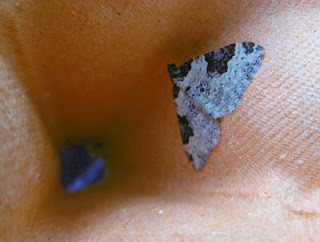I'm going to do one of my Good Housekeeping audits here tomorrow, but suffice to say that the monthly total is now somewhere in the mid-sixties, not far short of last year's bumper 73 and far better than the 40 recorded in 2013, my first year of Oxford entomology. There have been some notable absentees so far, including the Elephant Hawk moths, but life in general is good. And I was very pleased with the reception accorded to a 'tame' Poplar Hawk which I took to friends last night. It is now exploring Summertown in north Oxford.
The most prominent of the newcomers last night was the Scalloped Hazel in my top picture, followed by the delicate White-pinion Spotted - a curious order of words to my way of thinking; I would expect it to have been called the Spotted White-pinion but there we are. It is a common moth in the Midlands and South but also has a little stronghold in South Cumbria, rather like Londoners who maintain a hideaway in the Lake District. The third new arrival, above, is the very subtly and agreeably patterned and coloured Coronet and then we have a Juniper Pug below. Update: no, Dave Wilton confirms that it's a Mottled, which seems the commonest pug in this part of the world.
Much the most common moth in the trap was the Common (appropriately) Swift which comes in so many variations, including this rather striking grey form. This could possibly be a close relation called the Map-wing Swift. If the amazing and beyond-praise Ben is reading, he will know, or I may ask the experts on the Upper Thames Moths blog.
Finally, micro time. And time is what I need to sort out these little chaps. I have a couple of others in my unsolved file (which Ben entirely cleared yesterday so far as macros are concerned - what a hero). So there will be more news soon. Hope you are having a nice and not too wet weekend.


































































